1,250 miles later: VFF Sprints & Bikilas
Over the last two racing seasons, I’ve used Vibram Five Fingers Sprints and Bikilas in training and racing a number of events ranging from 5K running races and sprint triathlons to half marathons, marathons, and an Ironman. In total, I’ve put about 500 miles on the Sprints and 750 miles on the Bikilas. Most of my running is done on paved surfaces, but I’ve even done a little hiking and wear them casually quite often.
Today I’d like to review the FiveFingers Sprint and Bikila from a long-term use perspective. Let’s take a look at some pictures after the jump!
Vibram FiveFingers Sprints Long-Term Use Review
From a top down perspective they look like they are in pretty good shape still. You can see some white “fuzzies” that the Velcro picked up in the wash. I use the soak-in-vinegar/water-trick followed up by a run through the washing machine to clean them. This pair has probably been washed 10-15 times. The colors haven’t seemed to fade much despite being used out in the elements for hours and hours.
Flip them over and you can tell that they are well worn. I don’t have perfect running form and you can certainly see where my heel makes contact with the ground and has worn all the way through the rubber.
Oddly enough the left foot has a larger hole than the right foot. You can also see where some of the razor siping has also been worn away on the heels.
The hole doesn’t go all the way through the yellow inserts on the inside. They are still fairly comfortable to run in, but have been retired from running use and now used mostly for weight lifting.
Moving up the foot you can see where the razor siping has also been worn away on the balls of the feet. The big toe has lost a lot of material and the sizing numbers “M43” is almost completely gone on the left foot.
The sole has started to rip in a few places in between the toes, but this hasn’t seemed to affect anything. You can also see that the right foot still has the sizing number and more tread left than the left foot.
Vibram FiveFingers Bikilas Long-Term Use Review
Still looking good from the top! While not still sparkling white, the fabric colors and reflective bits have held up remarkably well. The material on the uppers has stretched a bit and is much easier to put on then my newer pair of Bikilas that only have about 50 miles on them.
The upper TPU toe protection over the toenail areas is thoroughly cracked and even has a bit of red tinge to them now which is probably from the dye running from use in the rain and going through multiple washes.
Flip them over and you can certainly see the wear compared to a brand new pair. The wearing on the heels and balls of the foot is consistent with the wearing on my Sprints.
The hole goes through the rubber sole, but doesn’t reach through to the inside of the shoe. Again, the right foot has the larger hole than the left.
The balls of the foot have some of the material worn away, but not nearly to the same extent as on the Sprints. The soles of Bikilas are thicker than the Sprints and this is most apparent here in the mid-foot section.
Closing thoughts
Both the Sprints and Bikilas have both held up well to a high volume running schedule. Whereas some of my training partners change out their shoes every 300-500 miles or so, the great thing about “barefoot style” running is that it doesn’t matter how worn FiveFingers are, they get more comfortable the more you use them. I’ve recently gotten a second pair of Bikilas and am slowly breaking them in by rotating them into my runs and casual wear. With the new pair, I can really tell how much the opening around the uppers on the older pair has stretched. The old pair slips right on, while the newer pair requires much more effort getting my foot into.
While I’ve found that the Sprints are at the end of their life for running, they are still very useful to use in the gym for heavy squatting or deadlifting routines where it really helps to have as little material between your feet and the ground. I will continue use the Bikilas for running and hope to get well over the 1,000 mile mark on them.






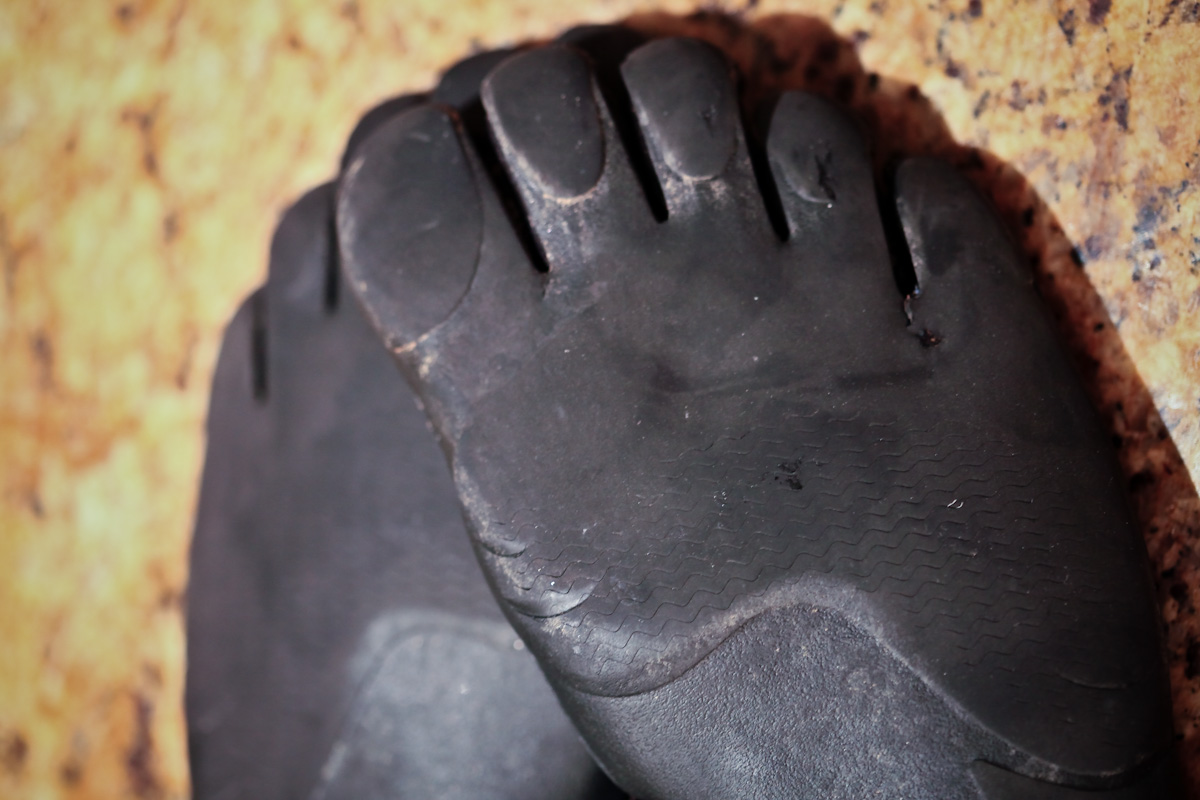
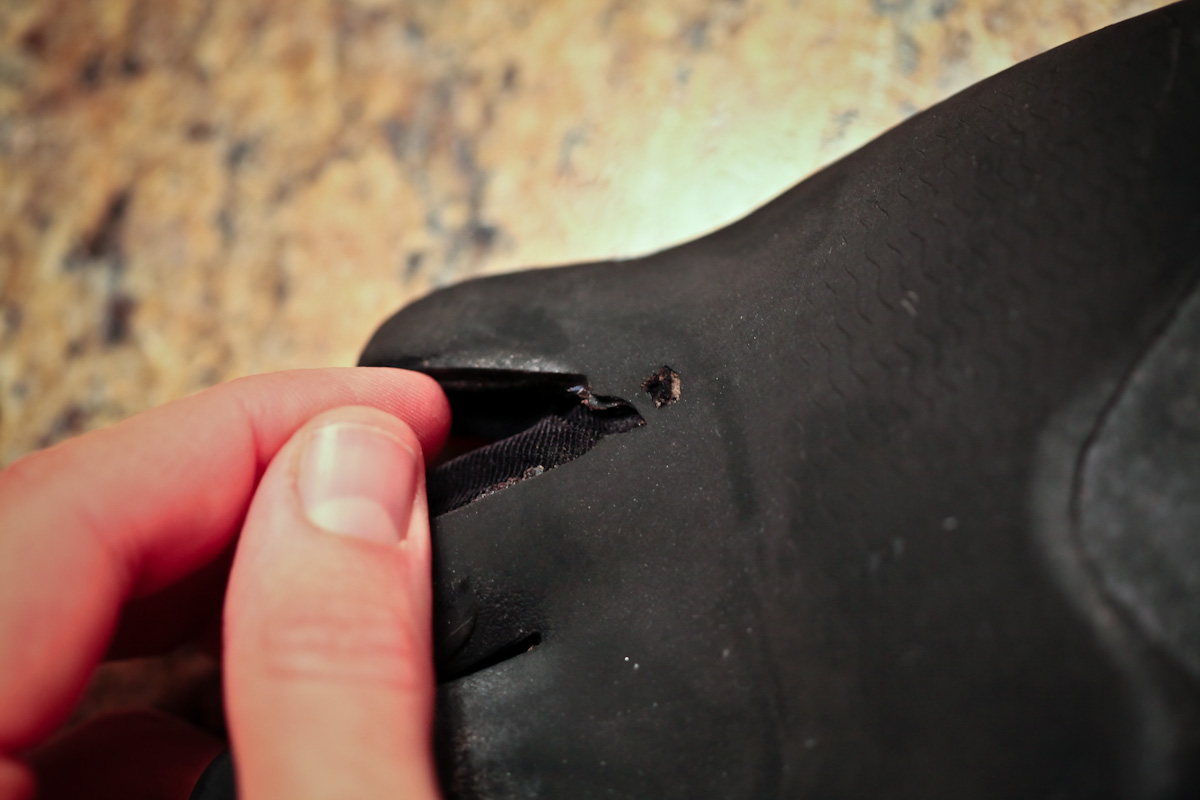

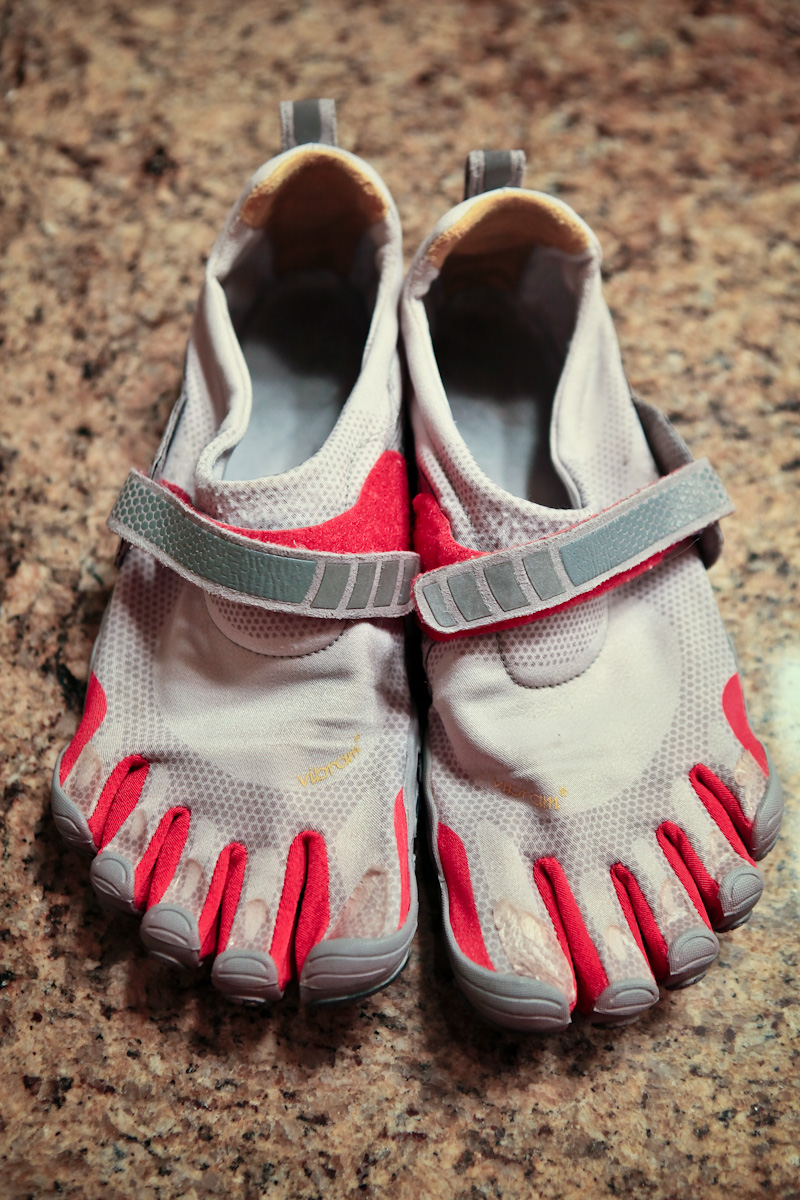

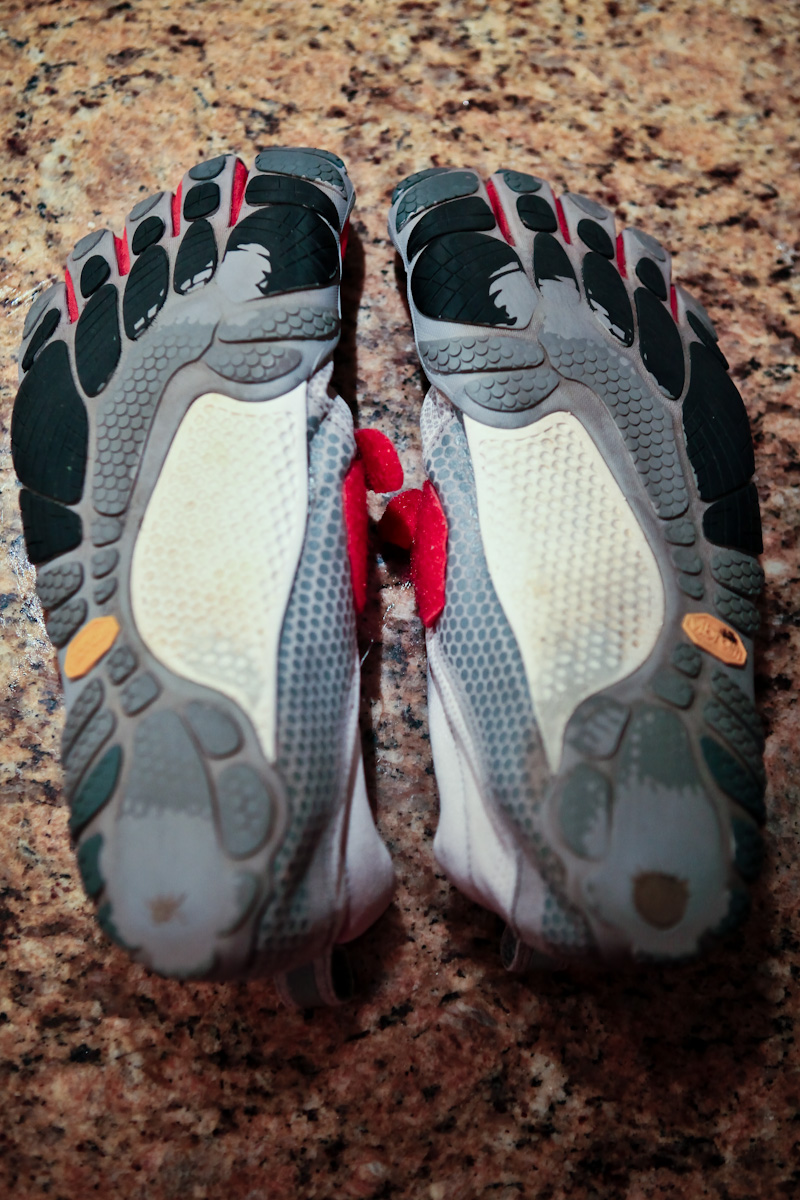
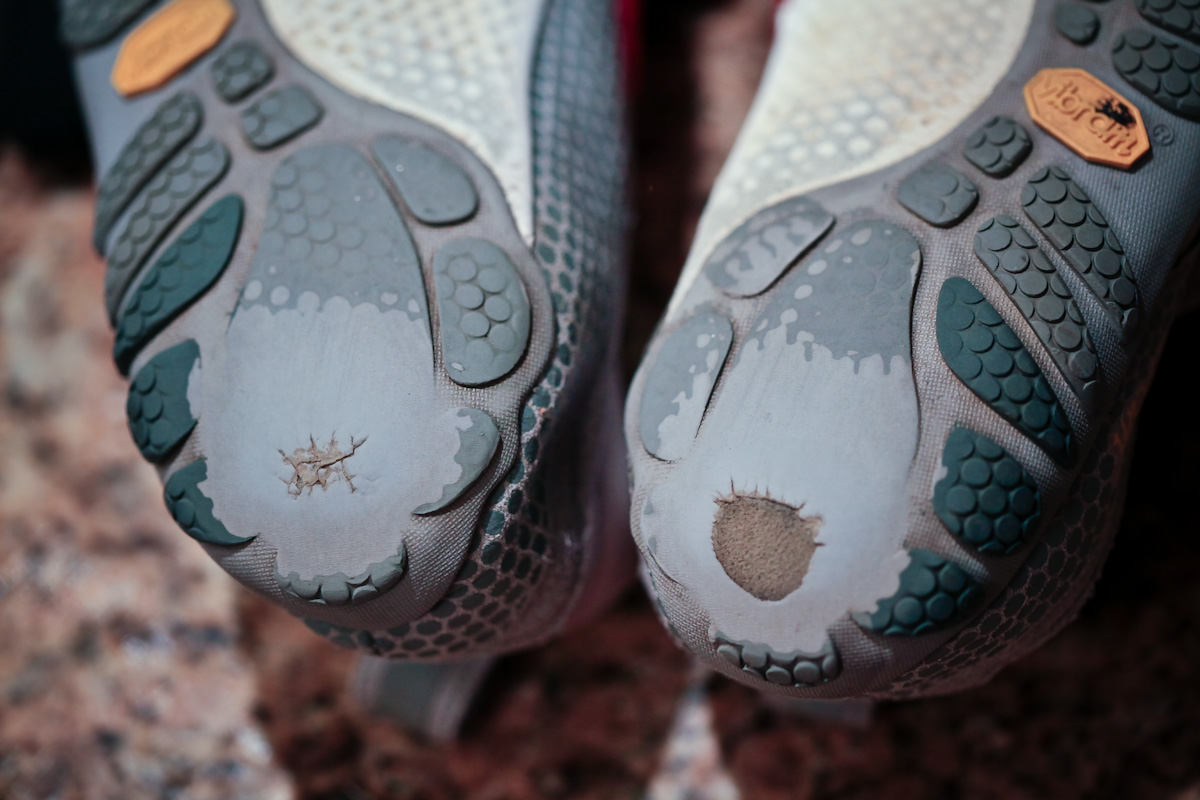

39 replies on “Vibram FiveFingers Bikila and Sprint Long-Term Review”
Great article. I got very worried about my Bikila’s at 700 miles, but have 1042 (as of this mornining’s track run) miles on them now.
You are definitely heavier on your heels than I am.
I don’t have any holes yet, but I can tell it’s not going to be long. I can see through the rubber in places to see writing on the liner/other side of rubber.
I’ve got pictures at 700 miles and 1000 miles on my blog.
http://d0gz.net/blog/2011/04/27/1000-miles
Thanks for the review, Tim! I don’t see many other people running in Bikilas where I live, so I haven’t been able to compare notes on how they hold up over time.
The soles of your Bikilas look a lot like mine. It’s good to know that yours have held up after 750 miles. I have been running in mine for over a year now (probably over 300 miles now), and, while some of the outer rubber on the soles is wearing down, they still have many, many miles left in them for sure. For reference, I used to switch out my Brooks after only 200 miles.
I totally agree that the Bikilas relax and and become more and more comfortable over time.
My only gripe is with the white footbed. In mine, they were permanently grey after only a month or so.
I firmly believe that the Bikila is the best minimalist road running shoe available.
I got to about 700 miles on my first pair of Sprints before the sole holes were to big and started letting in rocks. Figured I should replace them after that!
Still, that’s pretty impressive given how little “shoe” exists between me and the road. Love it.
Also: totally love that new foot smell.
Like you, I’ve worn some holes through the soles of my Vibram KSOs, Bikilas. I’ve had great success patching those holes, and even reinforcing newer pairs against wear using bicycle tube tire patches. They are the right thickness, the glue adheres very well, and they’ve extended the running lives of some of my favorite Vibram styles. I highly recommend them. There are many kinds. I’ve used these http://www.amazon.com/Rubber-Patch-Bike-Tire-Kit/dp/B000UVL5D0/ref=sr_1_36?s=sporting-goods&ie=UTF8&qid=1305041848&sr=1-36. The blue layer comes off, and the patches are black.
Interesting, especially since you run mostly on paved surfaces. I wonder if they would have lasted long/shorter if you were on dirt trails? I’ve worn my Sprints hiking on dirt/rocky trails and there would undoubtedly be puncture issues after awhile.
“Saucony has chosen to add a protective rubberized layer over some parts of the sole [of Hattori]. The heel, big toe and area just under the big toe have this extra layer. Some have questioned the positioning of these rubber bits and I haven’t really figured it out either. Why reinforce the heel in a shoe mostly used by minimalist runners who forefoot strike? Why not reinforce the forefoot area where they do strike?” –Britt.
Now we can see that the wearing pattern in these VFFs is rather close to the rubber reinforced areas in Saucony Hattori: the heels and the forefoot inner side area.
@Zephyr
Great observation. Looks like they hit it pretty close. I will have to update my Hattori post.
I’d go crazy keeping track of my mileage long-term like that. I just go running… no phone, no iPod, no watch, no shoes (mostly).
Interesting. I’ve been running in my Sprints about 4 years now, and I think they’re well over the 700 mile mark. I don’t have any wear on the heels to speak of, the tread patterns are pretty evenly worn off on the whole shoe, with a slight emphasis on the inside vs. the outside. But I started Chi Running before switching to VFFs, so I gave up heel striking a long time ago. I also run primarily on trails (bark, dirt, gravel), so they aren’t getting the wear that running full-time on pavement would give them.
I just got my Bikilas a few months ago, and I like them so much better than the sprints that I’m running in them 100% of the time now.
I’ve been waiting for someone else to comment on the location of the wear on the shoes…most everything I’ve read and my own experience) talks about landing on the fourth and fifth metatarsals…and being light on the heel. Am I completely off? Just confused as it seems the wear on these shoes would not indicate that sort of strike at all.
Interesting post nonetheless…and a testament to the ability for the shoes to hold up to wear and still perform.
I think the longer distances you run, the more likely you’ll get wear patterns like this; especially if you incorporate walking as well. I don’t think it’s a bad thing at all. I have similar wear patterns on my VFFs and other shoes. We all run/walk a bit different there is no one “right” way to do things. A lot also depends on what type of terrain you run on as well. As far as keeping track of mileage, it’s really pretty easy if you use DailyMile.com or other websites to record your mileage as there is a feature where you can add equipment to track. So you add your new pair of shoes and then when you log our run you just click on what shoe you wore and it tracks the shoe mileage automatically; easy!
IF you keep running on you heels you will experience damage toward your bones or hips later on in life…..Just learn to run naturally land on the ball of your foot….your heel should only tap the ground not rotate and cause friction or the constant pounding as you land…..
Thanks, looking to make my next purchase. I like to change every 1,500 – 2,000 miles.
I think if you run using your full foot, i.e. midfoot landing, you’re not only using the maximum surface area to absorb the shock, but you’re also going to experience similar shoe wear as the above. This is the way I’ve been running for a long time w/o any issues so far. Running itself is a demanding activity, sooner or later we’ll all break down one way or the other, only what injuries/weaknesses crop up will vary. Plus I’m still not convinced that if you are one who runs on mixed terrain (easy to rough trails, hilly, off trail etc…) that there is any one “correct” way to run. In terms of efficiency and speed I can easily see foot striking in a variety of different ways in such terrain and I do regularly w/o any issues. Now on fairly even surfaces like roads? That’s a different question entirely.
I agree with most of the above, but..
1) I recently added a new pair of Bikilas into my rotation to replace a well-worn pair of KSOs. But I realized after a couple runs how much better I like the KSOs! The Bikilas felt much thicker – my feet felt the ground better in KSOs. So I ended up exchanging them for a (3rd) pair of KSOs – black/gray cammo this time..
2) As much as the new KSOs make my feet feel good, there’s no comparison to how good the old ones feel! I guess there’s no shortcut to breaking in a new pair so they fit your feet perfectly..
Happy Running!
The sprints are in pretty good shape. The hole in the heel is nothing a good blob of Shoe Goo wouldn’t fix!
I agree with pedalpavementpounder, I was actually kind of shocked when I saw the wear pattern. I’ve had my KSOs for two years, and I’ve used them walking, running in canyons, on all weather tracks, pavement, and for Crossfit (weightlifting/ exercising), but the heels are by far the least worn place on the soles. I’m not an expert on running form, but you really shouldn’t land on your heels so much.
If it ain’t broke, don’t fix it! I’ve got similar wear patterns on most of my shoes. I think this is the difference between forefoot and midfoot striking. If your truly landing fairly flat footed (like I do) you’re going to be wearing out the midfoot and heel. I also think it’s a function of how far you run in a session as well. The longer you go the more likely your form is going to change and you might be involving the heels more (I know I do). I think the simple fact that one is wearing zero drop shoe (or minimal drop) makes the affect of heel striking much LESS important than the same action in a built up, high drop shoe. We’re talking a lot different geometry. We all run differently, I refuse to believe this is any ONE “correct” way to run. I say carry on sir!
You have put ~500 miles on Sprints but those been washed 10-15 times only. Thats odd, I hand-wash my training FF-s after each run with my clothes, that means a lot more washing, I’m wondering if I shorten the lifespan of my KSO-s and Classics considerably. I mostly run on loose stuf so there is a lot of dirt in the shoe after trainings even in KSO-s.
That looks like a dangerous wear pattern my friend. Maybe it’s just me, but my heels are nearly pristine by comparison.
I’d have to say that I have a similar wear pattern on my Bikila’s as well. I have about 550 miles on mine. I have run a couple half marathons and one full marathon in them. When I first saw the wear pattern I was a little concerned but I still continue to run pain free so I’m not going to change much.
It would be one thing if the only significant wear pattern on your VFFs (or any shoe) was *only* in the heel. But the fact that these appear to be roughly equally worn in the mid/fore foot and heel lead me to speculate this person is more of a *midfoot* striker as opposed to some on this forum who are *forefoot* strikers. I believe the forefooters would have significantly more forefoot wear and little to no wear in the heel because they don’t touch their heels at all. Which is better? Neither. I’m a midfoot striker myself and have been so for a long time w/o any injuries and 1000s of miles run. I like to think using your full foot on impact tends to distribute that impact force better as your using more surface area. Forefoot striking? Not so sure, seems to me that it could be as bad as heel striking in the sense that your still absorbing all that force over a smaller area. Not sure, but some of the extreme forefoot strikers I know have had injury issues… just like the heel strikers I know…
I just bought sprints and wore them for a 1 mile walk yesterday so I was glad to find these comments. Since it’s my first pair ever, I am unsure about fit. The toes feel fine, my heel fit firmly at the back of the shoe, but after the walk my ankles had deep red grooves where that little heel nub had dug into them… does that mean they are too small? I’m not sure if I should go up a size…
Regarding the wear pattern, it seems off to me as well. My KSOs are going on 2 years of steady use and the heels look nothing like those shown above.
Now a general and non-scientific observation: I have seen “several” people maintaining a heel strike in VFFs. It must work for them and the reviewer, as his marathons attest. But yikes – that wear pattern seems to fly in the face of most guidelines and my own personal experience wearing VFFs.
And again, this guy is clearly *not* a heel striker! What we’re observing here is more mid-foot which will involve fairly equal wear between the heel AND mid-forefoot area which is what you see in the wear pattern. I see nothing wrong with this. IMHO a heel strike only or fore-foot strike only will cause issues down the road; perhaps different issues but problems none the less. I’ve been running mid-foot for a *long time* and thousands of miles and haven’t had any issues. So who can say?
I’ve just got myself a pair of Bikila and it’s really snug, if not too tight. Length-wise it’s fine but I think I just have chunky feet. It’s interesting to read that the Bikila will stretch with time so thanks for posting this; I was on the verge of exchanging/returning mine. I’ll give it some time to stretch then though I do have a question: how much does it stretch?
Regarding the wear pattern, it seems off to me as well. My KSOs are going on 2 years of steady use and the heels look nothing like those shown above.
If your KSOs are not worn out after 2 years of use, you’ve probably not run a lot of miles in them, especially a lot of long single runs in them. This guy has done some long races in them and the type of wear is going to be different than a casual user who only does a few miles at a time. The longer distance you run the more likely your form is going to break down or that your going to perhaps walk thus a totally different wear pattern than someone who runs fairly short distances and can keep form together the entire time…
Hmm, I wonder what I’m doing wrong, but my pair of Speeds has extensive wear on the toe area. There is large hole on the second toe (the one next to big toe) on my left shoe and on the right one there will be hole very soon (matter of weeks). Otherwise the wear pattern seems similar than the pictured Bikilas (except a lot less wear still in my pair). I have ran about 300 miles with these, 90% paved roads, some dirt and trail and forest. I was planning to run a marathon (my first one) with these in August, but I had to order another pair now that rocks are staring to enter the shoe.
I have a long run compltely on sand coming up (50mile) my current shoes (with mesh) fill up with sand. Whats the feeling of users of Bikilas…will sand/grit get in and cause friction? Suppor ton soft and hard sand?? Look forward to comments..Thanks
@Tony (Finland). I had a pair of Vibram Komodos that I ran on pavement/tarmac and I had a hole on one toe (4th digit) at about 120 miles and 2 months of usage. The forefoot sole and the rest of the toes were also looking pretty polished (i.e. the big tread detail on the Komodo soles were obliterated) when I photographed them for my retailer who agreed that they were not demonstrating durable qualities, so offered a full refund… which is why I’m presently scouring the internet for information about which Vibram has a good durability record for road runners like me! Bikila vs Treksport hmmm (don’t feel I need to pay extra for LS variants)
Wow, you’ve put quite a few miles on your Bikilas and have not seen that much wear. Me, on the other hand – I’ve maxed my Bikilas out at about 600 miles. At that point, they had holes and other tears that made it quite impossible to run in without taping up my actual toes to prevent contact with the ground. Here is an image of what my Bikilas looked like at their retirement:
Uploaded with ImageShack.us
Either way, good luck with running in them! I’ve upgraded to the Bikila LS and I love them. Will take some time to break them in, but these are fantastic shoes.
Ran in KSOs for nine months and now Bikilas for three. I love the Bikilas, and although they were very tight when I got them, they feel great now. I do think the KSOs allow you to feel the ground more, and I sort of like that. All three pair went through the washer today and look like new. I do wear my heels, also, but haven’t had any foot issues in a year. Ran barefoot this past summer in grass and loved it!
Does anyone know where I could buy a pair of Sprints for men? Have they been discontinued because they seem quite difficult to find?
I had a cousin in the states order mine via email since we don’t have vibram where I come from. I had to order a women size since my feet are small. i carefully took measures of my feet before which one to order. So I finally got them via mail yesterday and had a hard time with the opening. I was thinking about returning them but manage to fit them and decided to stretch them for an hour or so…now my feet and ankles hurt! Should I give up on them or keep stretching them?
@Rafael Solis–the uppers of the Bikilas do stretch over time. Depending on how tight they are, tou could try stuffing them with something when you’re not wearing them.
Thanks for the advice, Tim!
I wore them at the gym today and they did feel better! Hopefully they will stretching. 🙂
Great story. My Bikila LSs have a few miles on them now. Wish I had kept track not really sure what the best way to do that is. Wish gamin did it for me.
I FINALLY retired my bikilas (replaced them with another pair of Bikilas 🙂 ) after 1200 miles. They could probably get me through another hundred miles or so but, they have formed “hot spots” so to speak that leave blisters. Therefore, the new ones are being broken in so I can switch permenantly, and use my old bikilas as casual shoes 🙂